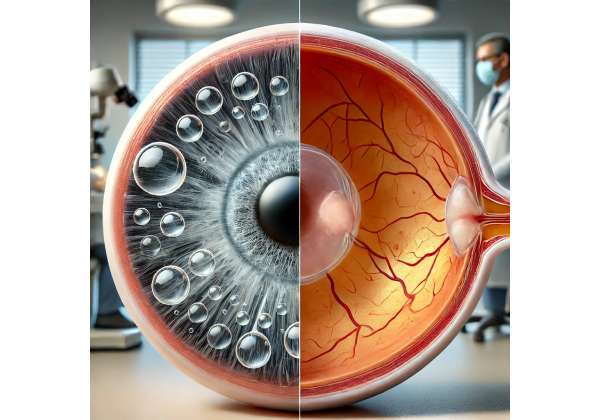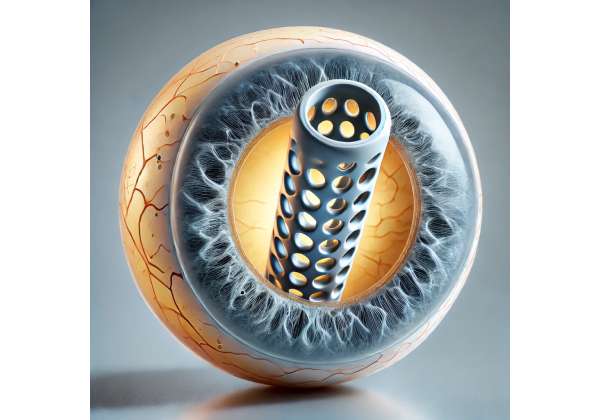Glaucoma Management with Microcurrent Neurostimulation Enhancing Vision Health
Glaucoma remains one of the world’s leading causes of vision impairment, affecting millions of individuals across various age groups. This eye condition often arises from elevated intraocular pressure (IOP), but it can also develop even when pressures appear normal. Regardless of its origin, glaucoma progressively damages the optic nerve, leading to gradual loss of peripheral vision and, if left...
Genetic Vision Repair with CRISPR-Cas9 A New Hope for Bardet-Biedl Syndrome Patients
Bardet-Biedl Syndrome (BBS) is a rare genetic condition characterized by a range of symptoms, including vision loss that often progresses to blindness. As the genetic underpinnings of BBS have become clearer, new therapeutic possibilities have emerged. Among these, CRISPR-Cas9 gene editing has gained remarkable attention for its potential to correct specific mutations in the genes linked to this syndrome,...
Gene Therapy Using Luxturna How This Revolutionary Treatment Offers New Hope for Leber’s Congenital Amaurosis
Leber’s Congenital Amaurosis (LCA) is a rare genetic disorder that impairs vision from birth or early childhood. Affecting the retina, LCA arises from mutations in specific genes responsible for converting light into signals that the brain interprets as vision. In recent years, scientific advancements have given rise to innovative treatments that promise to restore or significantly improve vision in...
Fluorometholone Eye Drops: Targeted Relief for Allergic Conjunctivitis Sufferers
Allergic conjunctivitis is an eye condition that can cause intense itching, redness, and watery discharge, all of which significantly reduce the quality of life for those affected. Whether these symptoms stem from seasonal allergies, indoor irritants, or various environmental triggers, individuals often experience considerable discomfort and are eager to find safe and effective relief. This is where fluorometholone eye...
Fighting Uveitis with Molecular Hydrogen A Natural Anti-Inflammatory Solution
Uveitis encompasses a diverse group of inflammatory disorders affecting the uveal tract—the iris, ciliary body, and choroid—often leading to profound discomfort and potential vision loss if left untreated. In many cases, the disease arises from autoimmune or idiopathic mechanisms, with the body’s own immune system attacking ocular structures. Patients might experience redness, blurred vision, light sensitivity (photophobia), and floating...
Femtosecond Laser-Assisted Cataract Surgery: Precision and Speed for Optimal Cataract Recovery
Redefining Vision Restoration: A Fresh Look at Femtosecond Laser Cataract Procedures (Introduction) Cataracts remain a leading cause of reversible vision loss, affecting millions of people worldwide. They occur when the crystalline lens in the eye becomes clouded, often due to age-related changes, but also arising from factors like trauma, metabolic disorders, or certain medications. Traditionally, the gold standard for cataract...
Fecal Microbiota Transplantation (FMT) for Non-Infectious Uveitis: A Breakthrough in Immunomodulation
Unveiling the Potential: Introduction to Fecal Microbiota Transplantation for Non-Infectious Uveitis Non-infectious uveitis is a sight-threatening inflammatory condition that affects the uveal tract of the eye, including the iris, ciliary body, and choroid. Unlike infectious uveitis (caused by viruses, bacteria, or fungi), non-infectious uveitis often has an underlying autoimmune or idiopathic etiology. A persistent and dysregulated immune response can lead...
Faricimab (Vabysmo) The Dual-Action Breakthrough Therapy Transforming Diabetic Retinopathy and Macular Edema Care
Faricimab—marketed under the brand name Vabysmo—represents a cutting-edge approach to treating diabetes-related eye conditions. By leveraging a distinctive dual-action mechanism, it seeks to reduce damaging blood vessel growth and inflammation, two key factors linked to conditions such as diabetic retinopathy and diabetic macular edema. This article offers an in-depth look at Faricimab’s unique mechanisms of action, its potential benefits,...
Faricimab (Vabysmo) Dual-Action Treatment Targeting Vision Loss in Wet Age-Related Macular Degeneration Patients
Wet age-related macular degeneration (wet AMD) remains one of the primary causes of irreversible vision loss in adults over 50, with a profound impact on the ability to perform everyday tasks—reading, driving, and recognizing faces among them. Characterized by abnormal blood vessel growth beneath the macula (the central portion of the retina), wet AMD often leads to rapid deterioration...
Eysuvis for Dry Eye Disease Relief from Inflammation and Discomfort with Advanced Loteprednol Ophthalmic Suspension
Understanding the Role of Eysuvis in Managing Persistent Eye Irritation Dry eye disease affects millions of individuals worldwide and arises from multiple factors, including insufficient tear production, poor tear film quality, or a range of inflammatory responses on the eye’s surface. As the condition grows more prevalent—particularly among people who spend long periods in front of digital screens or live...
Eylea’s Role in Diabetic Macular Edema Modern Treatment for Reducing Swelling and Improving Visual Outcomes
Unraveling the Challenge of Diabetic Macular Edema Diabetic macular edema (DME) is a vision-threatening complication that arises from diabetic retinopathy, one of the leading causes of blindness worldwide among working-age adults. People with diabetes frequently experience chronic hyperglycemia—elevated blood sugar levels—which, over time, can cause damage to the tiny blood vessels in the retina. The retina is the light-sensitive tissue...
EyeMax Mono A Cutting-Edge Intraocular Lens Option for Cataract Patients with Age-Related Macular Degeneration
Exploring the Need for Advanced Cataract Solutions in AMD Patients Age-related macular degeneration (AMD) stands among the leading causes of visual impairment in older adults, often overlapping with the onset of cataracts. As these conditions progress, patients may experience a significant decline in everyday visual function—reading becomes challenging, and tasks like driving at night or recognizing faces can become nearly...
EyeFlow Stent: The Next-Gen Glaucoma Stent for Enhanced Fluid Drainage
Shining a Light on Innovation: A New Way to Manage Glaucoma Glaucoma remains one of the foremost causes of irreversible blindness worldwide. Characterized by progressive optic nerve damage, it often stems from elevated intraocular pressure (IOP) due to poor aqueous humor drainage. Although pharmaceutical eye drops, lasers, and incisional procedures have long formed the backbone of glaucoma management, they may...
Extended-Release Aflibercept: New Formulation Offering Enhanced Diabetic Retinopathy Control
Pioneering a New Standard in Diabetic Retinopathy Management Diabetic retinopathy (DR) is a leading cause of vision impairment worldwide. It stems from chronic hyperglycemia, which damages the delicate microvasculature in the retina. This damage accelerates abnormal blood vessel growth, fluid leakage, and macular edema—collectively driving progressive loss of visual function. For many years, anti-VEGF (vascular endothelial growth factor) injections have...
Exosome Therapy for Retinitis Pigmentosa: Clinical Trial Insights and Developments
A New Era for Retinitis Pigmentosa: The Potential of Exosomes Retinitis Pigmentosa (RP) is a broad group of inherited retinal dystrophies characterized by progressive photoreceptor degeneration. At the molecular level, a range of genetic mutations triggers the gradual loss of rod photoreceptors, followed by cone deterioration in later stages. The result is compromised night vision, constricted visual fields, and eventual...
Exosome Therapy for Diabetic Retinopathy: Reducing Retinal Oxidative Stress
A Novel Introduction to Exosome Therapy for Diabetic Retinopathy Diabetic retinopathy (DR) remains one of the foremost causes of vision impairment among working-age adults worldwide. As diabetes advances, chronic hyperglycemia and fluctuating insulin levels damage the delicate blood vessels in the retina, triggering a cascade of inflammation, oxidative stress, and, ultimately, vision-threatening complications. Traditional management of DR relies on optimizing...
Evaluating AAV8 Gene Therapy for Cone-Rod Dystrophy: A Solution for GUCY2D Mutation
A Fresh Perspective on Cone-Rod Dystrophy Linked to GUCY2D Cone-rod dystrophy (CRD) refers to a group of inherited retinal diseases characterized by progressive dysfunction of the cone cells responsible for central and color vision, followed by declining rod function, which impairs peripheral and night vision. One of the genetic culprits is GUCY2D, a gene encoding guanylate cyclase 2D—a critical enzyme...
Erythropoietin as a Neuroprotectant for Glaucoma: Safeguarding Retinal Health
Unraveling Erythropoietin’s Role in Glaucoma Care Glaucoma, a leading cause of preventable vision loss worldwide, arises primarily from elevated intraocular pressure (IOP) that compromises the optic nerve over time. Traditionally, treatments have centered on reducing IOP—through eye drops, laser procedures, or surgeries—to decelerate disease progression. However, the neurodegenerative component of glaucoma has spurred research into agents that protect nerve tissues...
Epioxa (Epi-On Cross-Linking): Minimally Invasive Long-Term Solution for Stabilizing Keratoconus
Introducing Epioxa: A Breakthrough in Epi-On Cross-Linking Keratoconus is a progressive eye disease in which the cornea—the clear, dome-shaped surface at the front of the eye—gradually thins and bulges into a cone-like shape. This irregular curvature can distort vision, leading to complications such as blurriness, double vision, and sensitivity to light. While this condition can significantly impact quality of life,...
Endothelial Cell Injection Therapy: A Revolutionary Approach for Fuchs’ Corneal Dystrophy
A New Frontier in Restoring Corneal Clarity Fuchs’ endothelial corneal dystrophy (FECD) is a progressive eye disease that affects the innermost layer of the cornea, the endothelium. Over time, patients may experience blurred vision, glare, or even debilitating sight impairment due to endothelial cell loss and excess fluid buildup in the cornea. Historically, corneal transplantation has been the standard solution...
Endoscopic Cyclophotocoagulation Surgery for Glaucoma: Lowering Intraocular Pressure with Laser Treatment
Introducing a Laser-Based Breakthrough: ECP for Glaucoma Management Glaucoma stands among the most common causes of irreversible blindness globally. This group of eye disorders typically manifests through elevated intraocular pressure (IOP), progressively damaging the optic nerve and leading to gradual vision loss if left unchecked. While medications and laser procedures have long served as mainstays for controlling IOP, modern surgical...
Emadine: Advanced Relief for Allergic Conjunctivitis Through Emedastine Ophthalmic Solution
A Fresh Look at Emedastine and Its Role in Ocular Allergy Relief Allergic conjunctivitis is one of the most common eye conditions worldwide, affecting millions of people each year. It occurs when allergens—such as pollen, pet dander, dust mites, or molds—trigger an immune response in the conjunctiva, leading to redness, itching, tearing, and discomfort. For individuals who regularly battle these...
ELZA-PACE Protocol: Advanced Epi-On Cross-Linking Providing Precise Stabilization for Keratoconus
Keratoconus is a progressive eye disorder characterized by thinning and bulging of the cornea, resulting in a cone-like shape that distorts vision. Although various management options exist, corneal collagen cross-linking (CXL) remains one of the most reliable methods for halting its advancement. Traditionally, standard cross-linking involves removing the corneal epithelium (“epi-off”), which can be uncomfortable and carry risks such...
Elios Vision: How the Latest Excimer Laser System Is Changing Glaucoma Care
Glaucoma continues to be a leading cause of irreversible vision loss worldwide, driving an urgent need for more advanced, effective treatments. Elios Vision represents a state-of-the-art Excimer Laser system designed to reshape and refine modern approaches to glaucoma care. By targeting the trabecular meshwork—the eye’s key drainage area—this innovative technology aims to reduce intraocular pressure (IOP) and slow the...
Cytisus: Detailed Overview of Benefits, Properties, and Safety
Cytisus is a remarkable herbaceous plant that has captured the interest of gardeners, herbalists, and researchers. Belonging to the Fabaceae family, Cytisus (commonly known as broom) is well-known for its striking yellow flowers, bushy appearance, and robust adaptability to various climates. Traditionally used in folk medicine across Europe and the Mediterranean, Cytisus has recently attracted modern attention for its...
Cytinus: Benefits, Active Compounds, Properties, and Applications
Cytinus is a truly unique plant that has long intrigued botanists, herbalists, and nature enthusiasts alike. Unlike many common garden herbs, Cytinus is a parasitic flowering plant that lacks chlorophyll and relies entirely on its host plants for nourishment. Despite this unusual lifestyle, Cytinus has been traditionally used for its potential medicinal properties and has even found a modest...
Cypress: Health Benefits, Applications, and Recent Research
Cypress trees have long captured the imagination with their stately beauty and timeless presence. Found in various parts of the world, these evergreen trees are more than just an ornamental marvel; they are a treasure trove of natural compounds that offer a wide range of benefits. Cypress is celebrated for its resilience, aromatic foliage, and the calming influence it...
Cyclamen: Benefits, Active Compounds, Health Properties, and Uses
Cyclamen is a charming flowering herb known for its delicate, upswept petals and uniquely patterned leaves. Beloved in gardens and cherished in traditional herbal remedies, Cyclamen offers an array of benefits that go far beyond its ornamental appeal. Native to the Mediterranean region and parts of Asia, this herb has a long history of use in folk medicine where...
Cutleaf Waterparsnip: Detailed Overview of Benefits, Properties, and Safety
Cutleaf Waterparsnip is a fascinating herb that grows naturally in wetland environments and has captured the interest of herbal enthusiasts, ecologists, and natural health advocates alike. Known for its uniquely dissected leaves and delicate white flower clusters, this perennial herb plays an important role in its ecosystem while offering a variety of potential benefits. For centuries, traditional healers have...
Cutleaf Coneflower: Nutritional Benefits, Uses, and Healing Properties
Cutleaf Coneflower is a captivating wildflower known for its unique, deeply lobed leaves and vibrant, daisy-like blooms. This herbaceous perennial, native to North America, has been valued in traditional medicine and natural landscaping for generations. Its stunning appearance makes it a favorite among gardeners, while its potential health benefits have sparked interest among herbalists and researchers alike. Whether you’re...








































